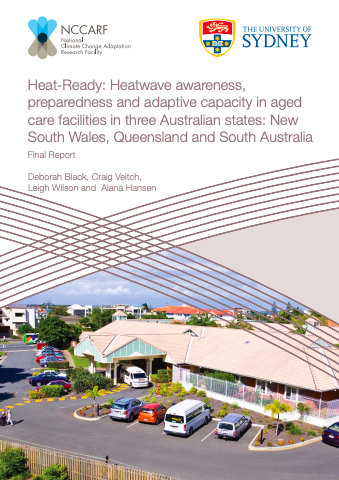Heat-Ready: Heatwave awareness, preparedness and adaptive capacity in aged care facilities in three Australian states: New South Wales, Queensland and South Australia (Final Report)
Organization: National Climate Change Adaptation Research Facility, Gold Coast
Year: 2013

Heat-waves are increasing in frequency, intensity and duration due to global climate change, and account for more deaths in Australia than any other natural hazard. Research has identified the aged, and those living in residential aged care facilities (ACFs), at increased risk of heat-related morbidity and mortality.
Aims
The study aims were to: 1) investigate current heat-wave planning, policies, staff knowledge and heat prevention strategies and 2) identify barriers to adaptation and successful implementation of adequate heat-wave health care in ACFs in three Australian states (NSW, Queensland and South Australia).
Methods
Residential ACFs were identified across three states using Department of Health and Ageing databases, white pages and internet searching. After removal of duplicates, 1,561 facilities were invited to participate in the study. Each participating facility was asked to provide informed consent and invited to select one administrative and one clinical staff member to participate in a 15 minute Computer Assisted Telephone Interview (CATI). Participants were asked about their knowledge of the effects of heat on the elderly and to detail current plans and policies which addressed residents’ health during heat-waves, and barriers to care during periods of extreme heat. Data was entered into a purpose-built database and analysed using Statistical Package for the Social Sciences (SPSS) Version 19.
Results
Two hundred and eighty seven (287) facilities (18%) participated in the telephone interview. The ACFs enrolled represented 20,928 Australian aged care residents. Ninety percent of facilities had a current ACF emergency plan, although only 30% included heat-wave emergency planning. Heatwave policies were not routine in all ACFs in any state. Staff used a range of strategies to keep residents cool in extreme heat, although strategies were not consistent across all states or facilities. The issues raised in relation to clinical care in this group can be synthesised into four key messages; cooling, hydration, monitoring and emergency planning, which, at a practical level are essential to maintain the health of older people in very hot weather.
Conclusions
This study identifies the current policies and strategies Australian ACFs use to keep residents well, and highlights the barriers to heatwave adaptation and maintaining wellness in the residential aged during periods of extreme heat. As the Australian population ages, planning for the health effects of extreme heat in elderly residents is critical to ensure wellness in this population group is maintained.